Nathan Myhrvold’s Recipe for a Better Oven
We cook our food using technology invented to bake bricks. We can do a lot better
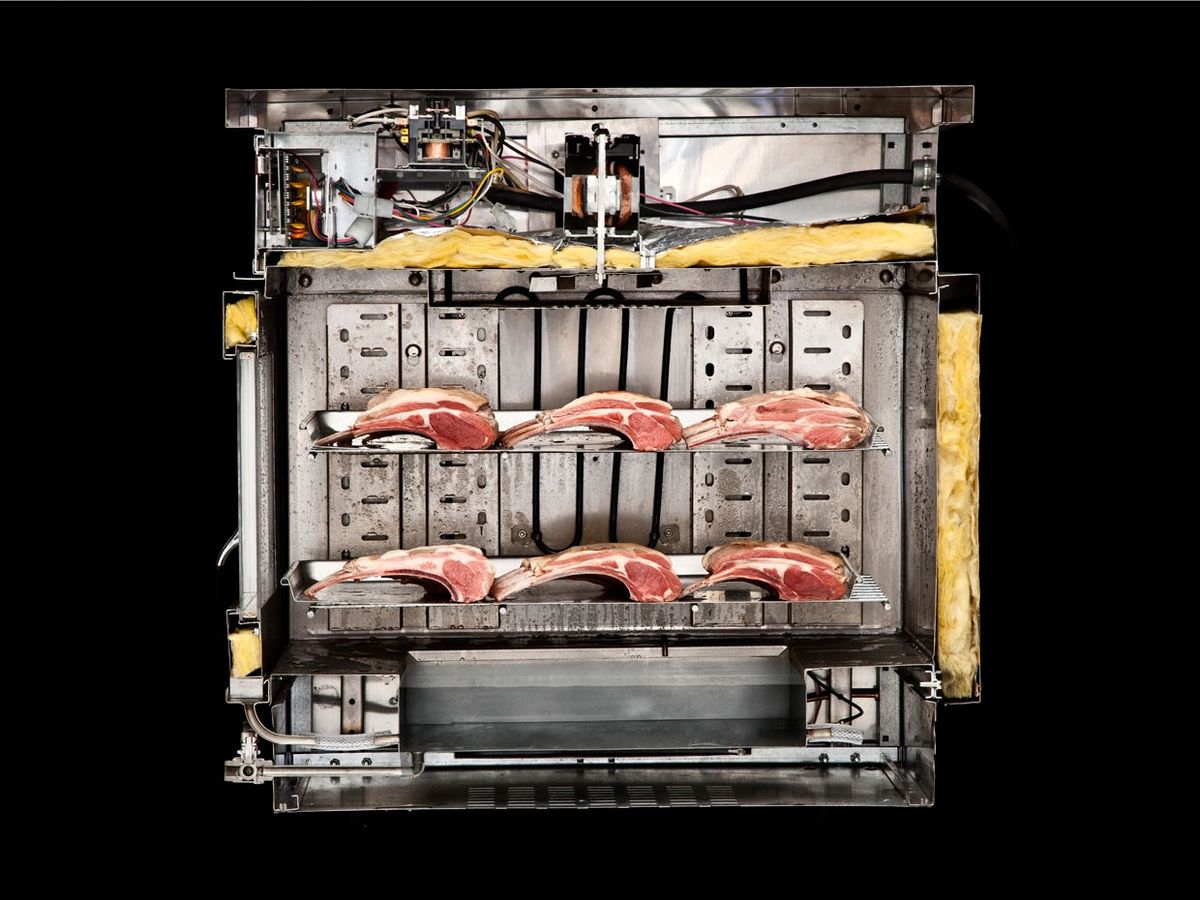
Is a brick dryer really the best system for cooking food? Not even close. The typical modern oven—even a US $10,000 unit used by professional chefs or a $5,000 model used in a high-end home kitchen—has a host of problems. It can’t cook food equally well whether full or nearly empty, left alone or regularly checked, or with food placed in any position inside. Yet oven manufacturers could solve every problem with existing technology, if only they would apply it.
The problems with ovens start as soon as you turn them on. Preheating always seems to take an unreasonably long time because ovens waste most of the hot air they generate. The actual amount of energy required to reach baking temperature is quite small: Just 42 kilojoules will heat 0.14 cubic meters of air to 250 °C. The heating element in a typical domestic electric oven supplies this much energy in a mere 21 seconds.
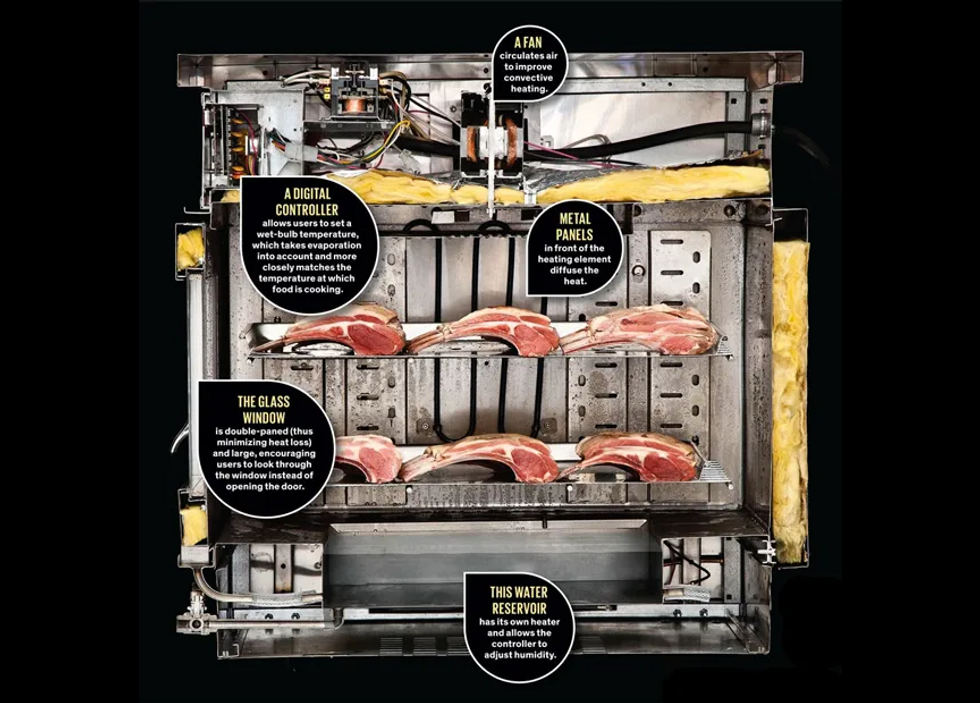
It’s the oven walls you want to preheat, however, not the air. Unfortunately, the heat, which originates in the heating coils of an electric oven or the burner of a gas oven, must pass through the air to get to the walls, and air is an awful conductor of heat, only slightly better than Styrofoam. Even worse, air expands when heated, so much of it flows out of the vent, heating the kitchen rather than the oven. And if you try to save that heat by closing the vent and adding a latch to the door, the oven might explode.
The time it takes an oven to heat up, however, is the least of the problems. Oven walls radiate heat unevenly because they vary in thickness and in their proximity to the heating elements. So the temperature can fluctuate by tens of degrees from one spot to another. And many oven doors contain a window, which radiates a lot less heat into the oven cavity than the walls do.
At low temperatures, these fluctuations don’t matter much, because radiant heat is weak compared to the heat transferred through conduction and convection; at high baking temperatures, the unevenness matters a lot. The power of radiant heat emitted from part of an oven wall at 270 °C is 16 percent more intense than the power coming from part of a wall that is slightly cooler, at 250 °C.
Food itself also absorbs radiant heat unevenly, which exacerbates the problem. Some parts of the surface naturally dry faster and brown earlier. Because dark surfaces absorb more radiant heat than light surfaces do, small variations quickly grow. If a darkening part of the food is particularly close to an intense spot of radiant heat, that part of the food will likely burn.
And you, the cook, will inevitably make the situation worse. As soon as you open the oven door to adjust or check on the food, nearly all the hot air spills out. The puny electric element or gas burner is no match for such large surges of cool air, so the temperature in the oven plummets, and it recovers slowly.
Oven designers could do a lot to make ovens heat more evenly by taking advantage of the different ways ovens transfer heat at different cooking temperatures. At 200 °C or below, convection moves most of the heat. But at 400 °C, radiant energy starts doing a fair amount of the heat transfer. At 800 °C, radiation overwhelms convection. Why couldn’t we have an oven designed to cook primarily by convection at low temperatures that switches to radiant heating for high-temperature baking?
And you’re not going to be able to stop a cook from opening the oven door on occasion—peeking through a grease-splattered window just doesn’t cut it. But designers could prevent that blast of cold air by building a blower into the door frame that generates a “curtain” of air whenever the door is opened, retaining more of the preheated air in the oven. Larger versions of air doors are already in wide commercial use for refrigerated warehouses. Designing one for an oven is trickier because the chamber is small and turbulent currents could do more harm than good. Still, it could be done.
Hot spots affect broiling as well as baking. Electric broilers use bars or rods made from Nichrome, an alloy of nickel and chromium (and often iron) that heats up when electricity passes through it. With reasonable energy efficiency, electric broilers can heat quickly and reliably to temperatures as high as 2,200 °C. Maximum settings are typically restricted to 1,200 °C in order to extend the life of the heating element and avoid charring the food.
Every broiler has a sweet spot—or perhaps we should call it a “sweet zone”—where the heat is at its most intense. If you place the food above or below this zone, it will cook unevenly. Moving the food closer to the heating elements won’t make it hotter; it will simply make the cooking more uneven.
Surprisingly, however, the opposite problem occurs when food is too far from the element: Cold spots appear directly below the rods, and hot spots fall in between. What has changed is that the distance to the element no longer causes heat intensity to vary much from side to side, but there are still variations in the way heat reflects.
HOW TO CALIBRATE YOUR OVEN
You can make that cantankerous contraption in your kitchen more predictable
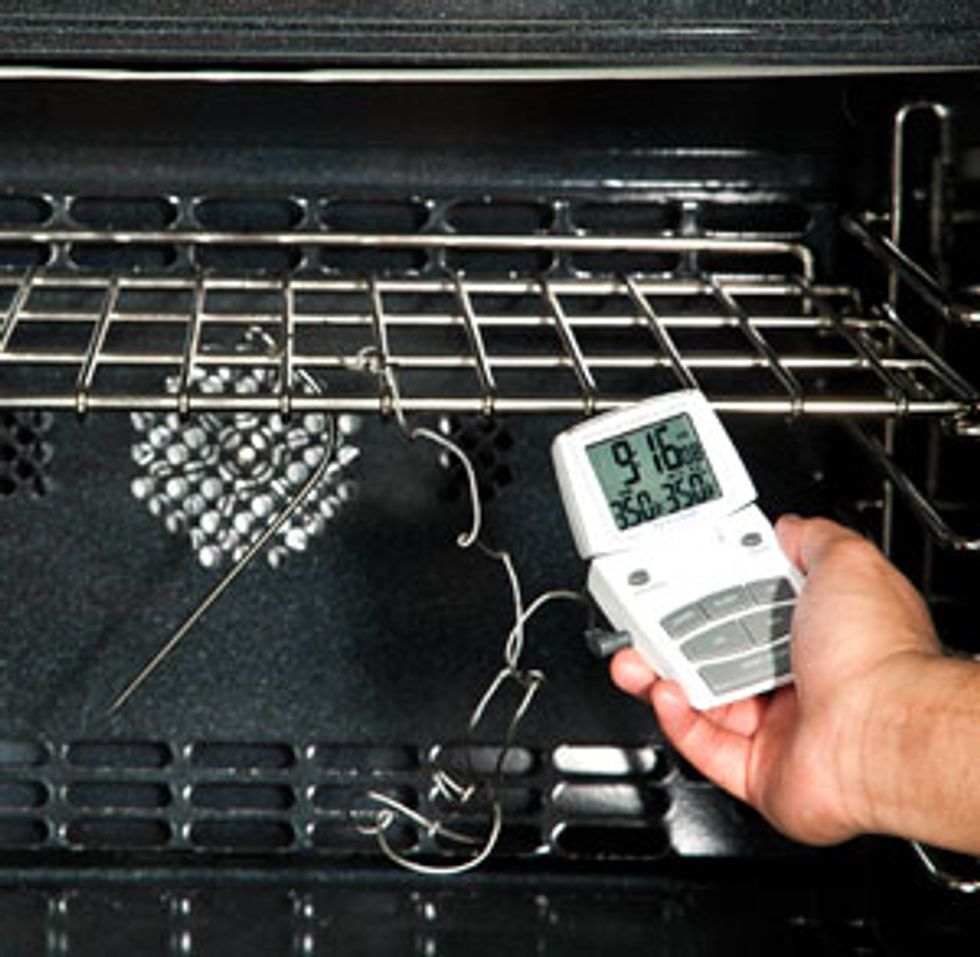
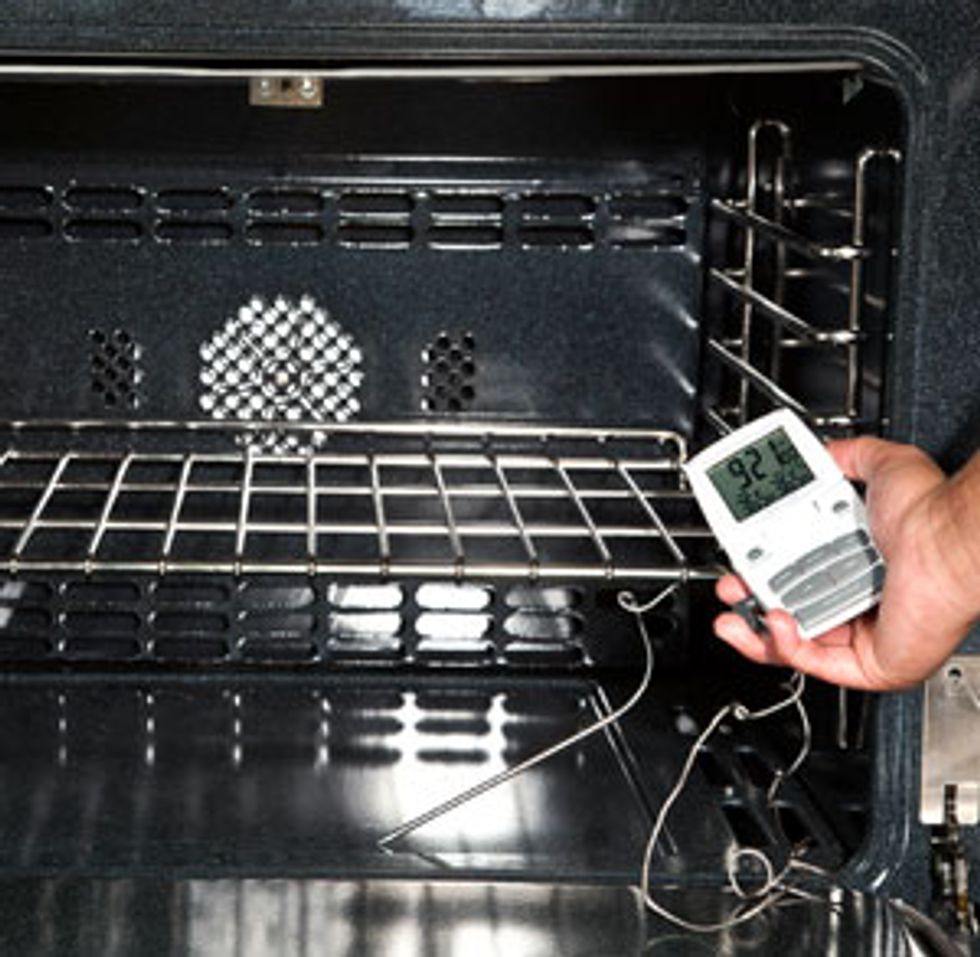
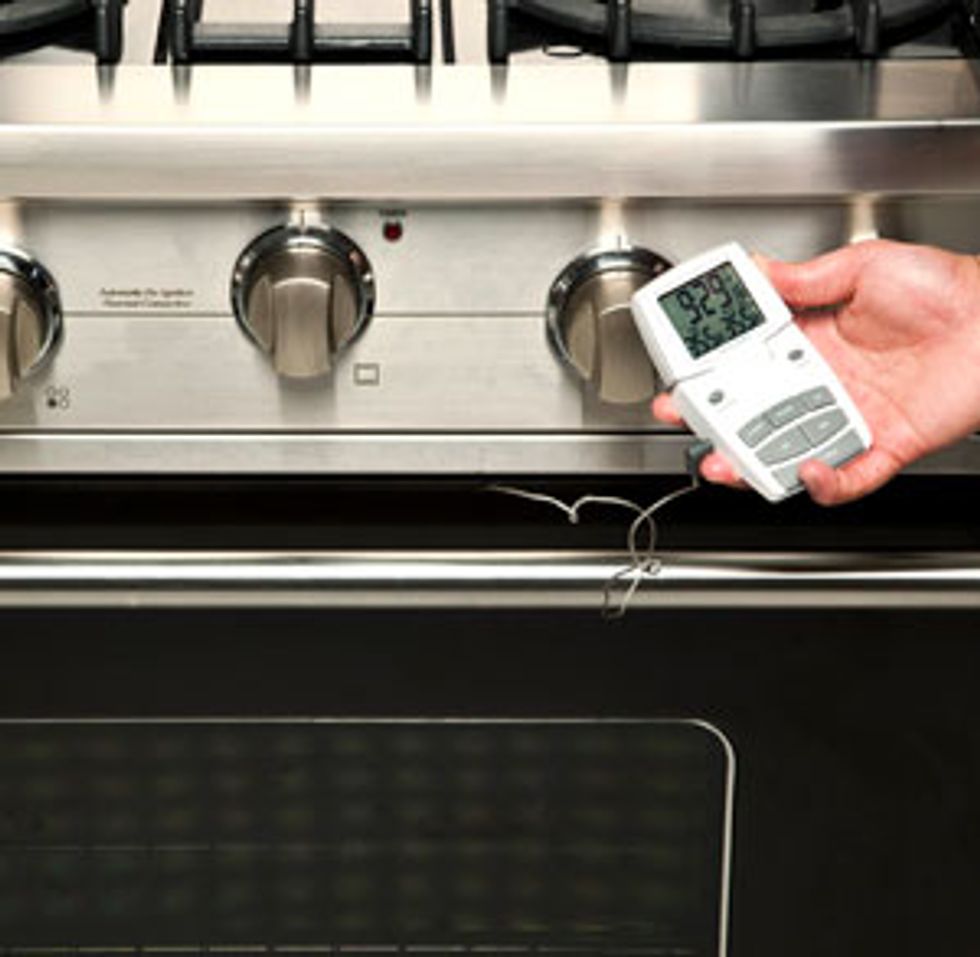
You can make a broiler cook more evenly with a simple DIY project: Install some shiny vertical reflectors near the edges of the compartment. Another good way to ensure that food browns evenly under a broiler is to wrap the dish with a reflective foil collar. But why should you have to jury-rig a fix? It wouldn’t be hard for oven manufacturers to build reflective materials into the oven. Viking Range is developing stainless steel cavities that are more reflective, but they need better materials that are easy to clean and don’t discolor when heated to high temperatures.
Such reflectors wouldn’t entirely solve the problem of uneven broiling. The food itself can cause variations. The shiny skin of raw fish reflects heat, but as the skin browns, it reflects less and less energy. That’s why food under a broiler can seem to cook slowly at first and then burn in the blink of an eye.
But technology offers a fix here, too. Oven designers could put optical sensors in the oven chamber to sense the reflectivity of the food, and then the oven controller could adjust the heat automatically or at least alert the cook as the surface browns. And a camera in the oven could feed to a color display on the front panel, giving the chef a clearer view of the food than a small window in the door can. Indeed, a decent optics system could allow designers to dispense with the glass in the door altogether, reducing the gap between the hottest and coolest corners of the oven and obviating the need to open the door and rotate the food midway through cooking.
We could also broil food more evenly by switching from standard electric or gas broilers to gas catalysis, a technology that has begun to get the attention of oven designers. Although still more expensive than other broilers, catalytic broilers are beginning to show up in professional kitchens and some high-end consumer ovens.
Instead of burning gas, flameless catalytic broilers push it through a catalytic metal that either permeates or forms a mesh around a porous ceramic plate. As the gas mixes with air, the catalyst makes it oxidize, creating heat, water vapor, and carbon dioxide. The ceramic plate absorbs the heat and radiates it out into the oven far more evenly than a conventional broiler.
Even though these catalytic broilers can reach only 540 °C, they brown food just fine. They are also very energy efficient, converting about 80 percent of the chemical energy in the gas to infrared light. This technology, however, needs work before it can be cost-effective for the home kitchen. In the meantime, oven designers should be seeking less expensive, similarly compact technologies to produce heat from gas that rival the efficiency of catalytic elements.
Another way to cook food more evenly is to turn it. Thick cuts of meat roast to more consistent doneness on a rotisserie because each part of the roast receives regular pulses of heat as it rotates toward, and then away from, the heat source. Between pulses, the heat diffuses into the center while the exterior cools. Some modern ovens do include rotating spits that can be used in conjunction with the broiler to make a rotisserie, but these can be awkward to set up and are limited in the sizes and kinds of foods they can cook.
A more advanced oven could offer the benefits of rotisserie cooking by pulsing the heat rather than rotating the food. The walls of the oven would have to quickly cycle between the high temperatures at which radiant heat transfer kicks in and those that are much cooler. That would probably require integrating a heat exchanger of some kind into each wall. A circulating fluid, for example, could draw heat off the walls and transfer it to a water-filled chamber at the bottom of the oven.
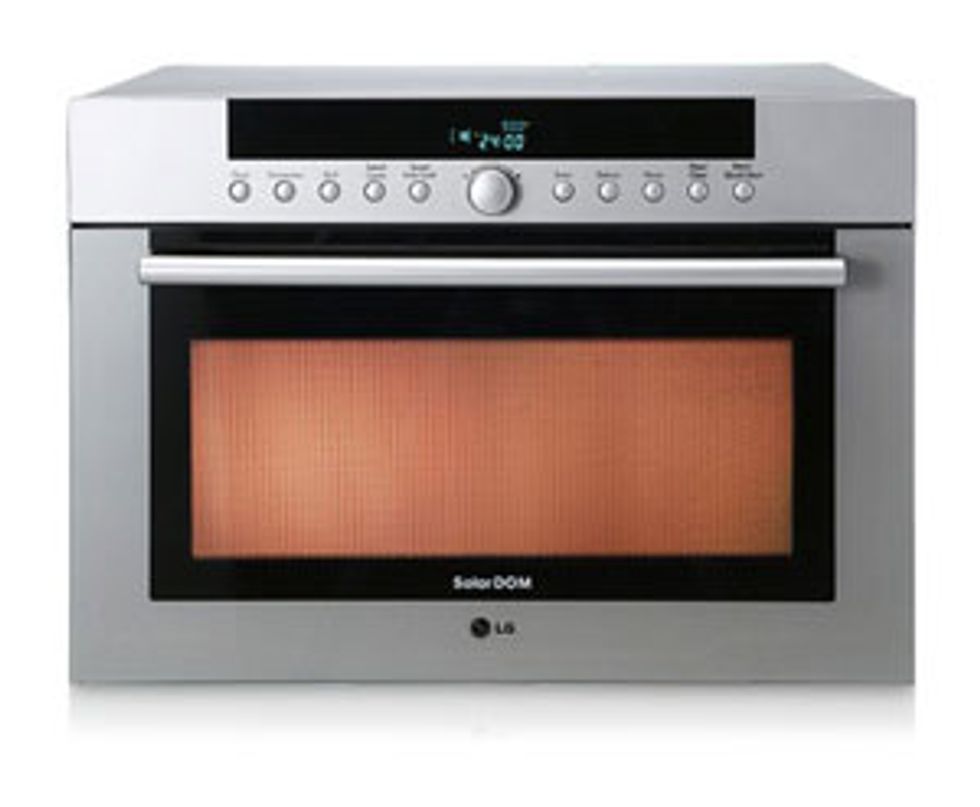
Heating with high-intensity light, from halogen lamps, say, might offer one way to create pulsating heat. And halogen ovens are available. General Electric makes ovens that incorporate halogen elements. LG Electronics makes a line of ovens, the Solardom series, that combine a conventional electrical heating element with a convection fan, a microwave generator, a halogen broiling element, and a water tray for generating steam (but without any accurate control of humidity level).
You can also create pulses of heat with oven wall panels that quickly change their conductance. One way might be through the use of variable-emittance coatings, which NASA and others have been developing for 20 years; these change their transparency or reflectivity when a current is applied. Another method would use tiny shutters made out of microelectromechanical systems or electrostatically actuated flaps.
So oven designers could indeed create appliances that heat both faster and more evenly. But a fundamental problem with today’s ovens would remain: We can’t control them properly because we can never accurately gauge just how hot they are! Sure, they have a purported control knob on the front labeled with various temperatures, but turning the control knob is a bit like spinning a roulette wheel—you never know exactly where the cooking temperature will end up (and, as we’ll explain later, the cooking temperature is very different from the temperature measured by your oven thermometer).
A brick-drying oven’s temperature can vary by 50 °C or even 100 °C and still produce a functional brick. Food is vastly less forgiving. Beef cooks nicely to an internal temperature of 55 °C, but raise the temperature to just 63 °C and the individual muscle strands in the meat contract dramatically, squeezing out the juices and leaving a dry, unappetizing entrée.
Domestic ovens tend to swing in temperature and can be off by as much as 5 percent at any point during cooking. At 205 °C—a temperature at which you might cook a turkey—that 5 percent isn’t a big deal. But consider a style of cooking known as sous vide, in which you cook food in bags in a water bath at low temperatures such as 60 °C, near the threshold at which bacteria can survive. Here, 5 percent can be the difference between safe and unsafe.
Controlling temperature would be easier were it not for more frustrating facts about ovens that conspire against consistency. The thermostats in nearly all traditional ovens are just plain inaccurate. As technologies go, the oven thermostat is underwhelming: It is nothing more than a switch that opens and closes in response to the temperature it senses. In the worst case, the sensing probe is behind the oven walls. In the best case, it protrudes into the oven cavity (it’s a metal tube with a crimped end). It’s filled with an incompressible fluid that responds to changes in temperature, just like an alcohol-filled glass thermometer.
This probe reads the dry-bulb temperature, the same type of temperature that an ordinary thermometer measures when it’s shielded from direct sunlight and moisture. Because the oven probe is some distance from the food, it typically mismeasures the real dry-bulb temperature by as much as 15 °C at high baking temperatures, typically around 220 °C and above, and often by even more at low temperatures, like 120 °C. The greater the distance between the sensor and the food, the bigger the error. You can calibrate the thermostat of your oven to compensate for these errors [see “How to Calibrate Your Oven”].
Even when perfectly calibrated, however, the standard oven thermometer has a big problem. Water evaporating from the surface of the food carries away heat, leaving the food cooler than the surrounding air. Scientists call this temperature at the surface of the food the wet-bulb temperature (that is, the dry-bulb temperature minus any cooling by evaporation). The lower the relative humidity, the more evaporative cooling, so the greater the difference between the two temperatures.
Because most of the humidity in an oven comes from the food, adding food to the oven raises the humidity and, therefore, the wet-bulb temperature at the food’s surface. This means that bigger batches bake faster. Did you burn the holiday cookies last year? Blame your oven’s ignorance of its own humidity.
Oven makers have two separate but related technologies that address this problem. Though not standard in commercial kitchens, these are gaining popularity. But they have yet to come to the home cook.
The first is the water-vapor oven, developed in the early 1980s by Winston Shelton, a former General Electric engineer. Shelton wasn’t new to kitchen innovation; in the early 1970s he worked with Colonel Harland Sanders to design and manufacture the Collectramatic pressure fryer, which became the standard cooker for the Kentucky Fried Chicken chain of restaurants.
Shelton’s Winston Industries calls its water-vapor technology CVap (short for controlled vapor). The basic concept is simple: Heat a pan of water in the bottom of an oven enclosure until enough evaporates to raise the relative humidity to almost 100 percent. CVap ovens sell for $4,000 to $9,000, depending on size.
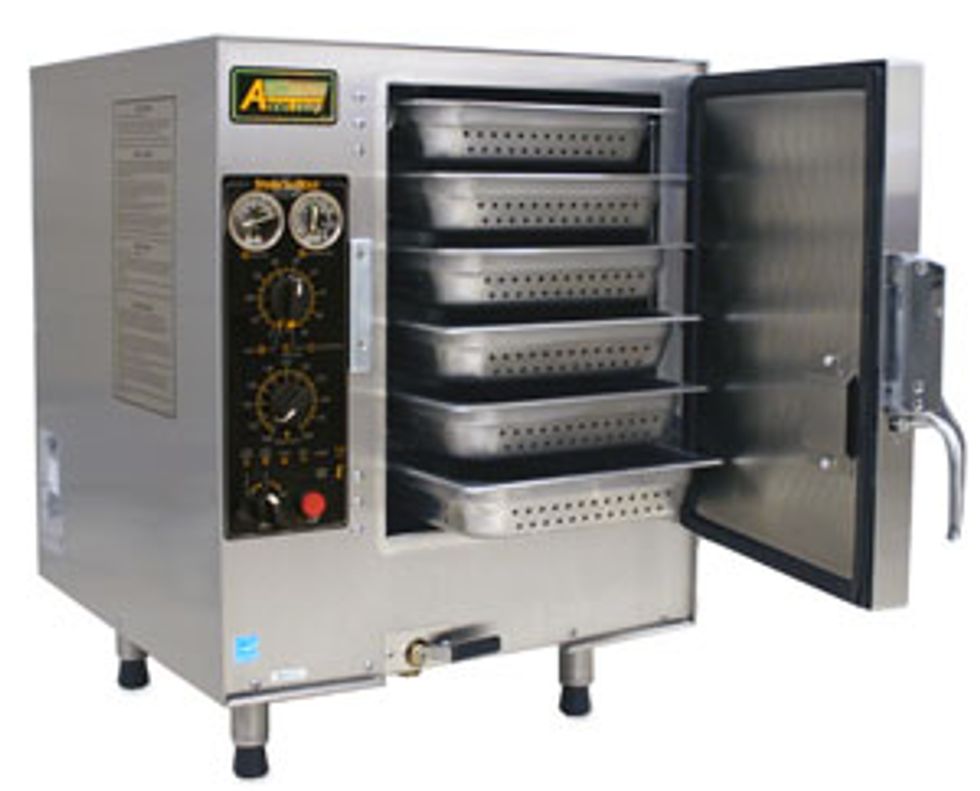
A second type of vapor oven, the Steam’N’Hold unit from the Indiana-based company AccuTemp Products, works by creating a partial vacuum that reduces the air pressure until the boiling point of water equals the temperature that the cook selects for steaming. This approach works only for temperatures below 100 °C. These ovens retail for around $6,000.
Neither kind of vapor oven can brown food, however, unless the surface of the food is dry. The combi oven, invented in 1976 by German engineers at the company that would later become Rational, is designed to both brown and steam food. Steaming goes beyond 100 percent humidity to put moisture into food. Combi ovens can cook with ambient air (as an ordinary convection oven does), with injected steam, or with a combination of both.
A combi oven is not cheap. It costs roughly $15,000 for an oven the size of a half sheet pan and several times that for larger configurations. Miniature combi ovens designed for commercial kitchens have recently come on the market for as little as $2,000, but these use very small pans. And the technology is starting to come into the home kitchen—Cuisinart makes a $300 oven that can toast or steam food.
Combi ovens offer far greater control of temperature than conventional ovens do, and they allow you to control the humidity, too—but unfortunately, not as well as we’d like. Our experiments show that the dry- and wet-bulb temperatures in these ovens tend to fluctuate by several degrees around the set point. Gas-fired ovens are worse than electric ones because the flame produces large pulses of heat as it turns on and off.
Modern humidity-controlled ovens such as CVaps and combi ovens share a common flaw. They don’t let you set the wet-bulb and dry-bulb temperatures directly. So our entreaty to the innovative engineers and designers in the appliance industry is simple. Please give us ovens that let us select separate wet- and dry-bulb temperatures! And while you’re at it, perhaps you could solve a related problem: the inadequate precision of the humidity- and temperature-control systems. Both temperature and humidity levels stray from the set points more than they should.
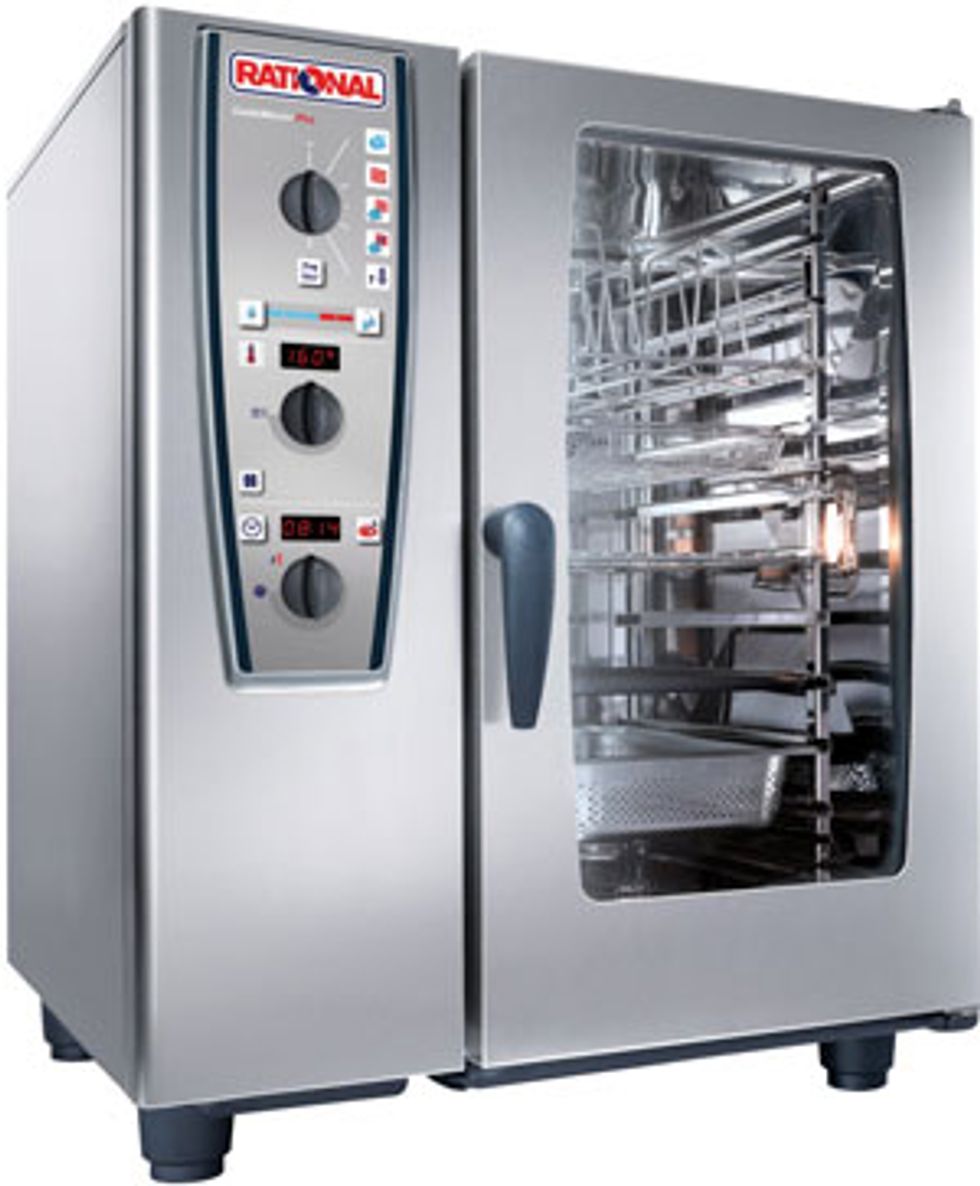
Precisely controlling the temperature and humidity of an oven means you can better control the actual temperature of the food inside it. And that’s what really matters. A chicken breast cooked to 60 °C is moist and delicious; cooked to 65 °C, it’s dry. An oven-baked omelet can be exquisite. But in today’s ovens it is nearly impossible to cook one properly, because a difference of even a few degrees from the perfect conditions—82 °C and 100 percent humidity—will produce either a runny omelet or one that’s dry and brittle.
Some other interesting technologies that make ovens more useful are already on the market. Newer models of steam ovens by Wolf Appliance have a “slow roast” mode that allows the cook to enter a serving time. Ovens made by Rational measure the core temperature of the food using a probe. The probe has five separate sensors; the machine’s digital control chooses the one placed deepest into the food. That way, you don’t need to hit the food dead center with the tip of the probe. The oven adjusts the temperature of the oven cavity automatically to control the rate at which the core temperature of the food rises.
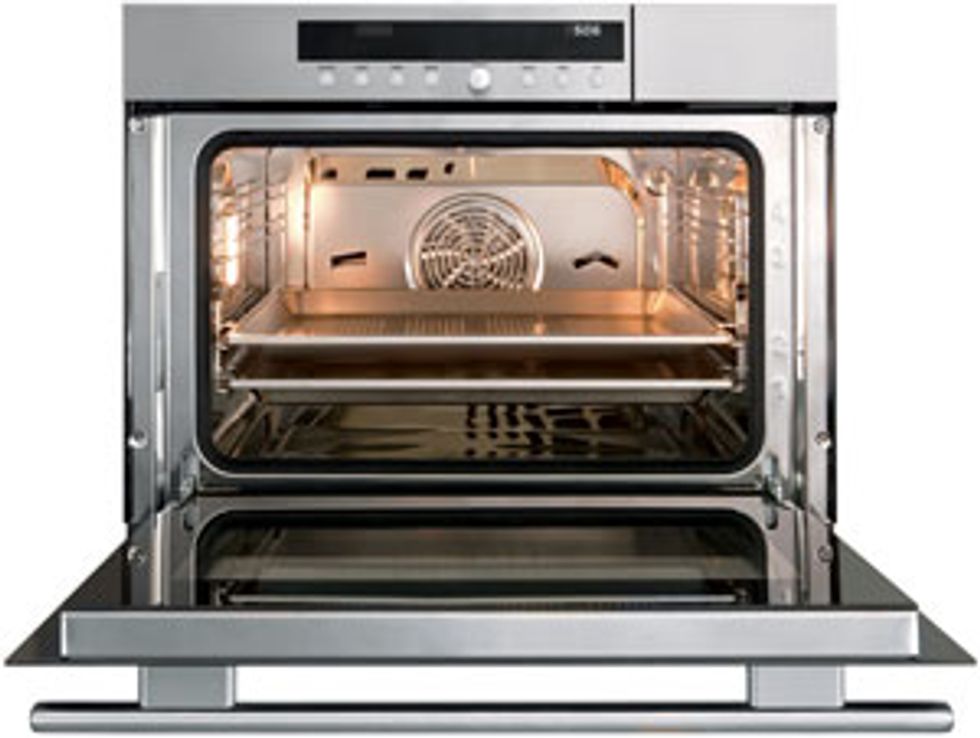
These developments are encouraging but isolated. An oven could be manufactured today that could incorporate many of the technologies now available and go a long way toward turning today’s mere brick dryer into a true food cooker. It would have wet- and dry-bulb temperature controls, better thermostats, probes to go inside food, and sensors that detect hot and cold spots. All these features would add just a few hundred dollars to the cost of the parts.
And adding just a little more intelligence to the oven could take us even further. A smarter oven would use both advanced sensing and mathematical modeling to observe and project the temperature trajectory within the food. It could then adjust its heating mode and intensity to create the optimal conditions for cooking that type of food or simply to have good, if not perfect, food ready at a selected time.
But why stop there? With ideal technology, you could put different parts of your meal in a single oven and it could figure out how to cook them so that they were all done at the same time in the way you want them. To do that, we need a way to focus just the right amount of energy on each part of the food and to measure how it responds to the energy. This would likely require ovens made out of new materials—not just sheet metal—that could be monitored and controlled in finely grained detail: Imagine an LCD in which each pixel gives off not colored light but powerful infrared energy. When you put a slice of toast on top, you could control how much heat is delivered to each spot on the toast—resulting in evenly toasted bread, or, perhaps, toast with a shaded image on its surface. That would be the ultimate cooking technology.
This article originally appeared in print as “Recipe for a Better Oven.”
About the Author
Nathan Myhrvold, founder of Intellectual Ventures and the Cooking Lab and former chief technology officer of Microsoft, cooked his family’s Thanksgiving dinner at age 9. Myhrvold and freelance writer W. Wayt Gibbs have collaborated on two noteworthy culinary works: the six-volume Modernist Cuisine: The Art and Science of Cooking (2011)and Modernist Cuisine at Home (2012).